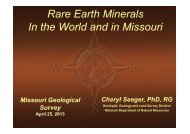Create successful ePaper yourself
Turn your PDF publications into a flip-book with our unique Google optimized e-Paper software.
1977; Love, 1984). REE concentrations are typically<br />
correlated with phosphorus content, due to<br />
an association with apatite. Despite its promise as<br />
a host of REE, the Phosphoria Formation has been<br />
the subject of few REE analyses (K<strong>in</strong>g and Harris,<br />
2002).<br />
Hoback, SW¼NE¼ sec. 32, T. 39 N., R. 116<br />
W., Southwestern Teton County<br />
The Phosphoria Formation crops out along US 89,<br />
near the historic town site of Hoback, <strong>in</strong> extensively<br />
folded and faulted terra<strong>in</strong>, and was the target of<br />
a phosphate exploration trench (Albee, 1968). The<br />
Phosphoria overlies the Mississippian and Pennsylvanian<br />
Wells Formation and is overla<strong>in</strong> by the<br />
Triassic D<strong>in</strong>woody Formation. The northeastern<br />
marg<strong>in</strong> of this outcrop is cut by a high-angle fault<br />
that places the Phosphoria Formation <strong>in</strong> fault contact<br />
with the Wells Formation (Albee, 1968). The<br />
Astoria m<strong>in</strong>eral hot spr<strong>in</strong>g is located 340 m (1,100<br />
ft) east-southeast of this outcrop (Breckenridge and<br />
H<strong>in</strong>ckley, 1978), and <strong>in</strong>dicates that the overall area<br />
may have experienced hydrothermal activity <strong>in</strong> the<br />
past.<br />
The Phosphoria Formation <strong>in</strong> this area (fig. 24)<br />
<strong>in</strong>cludes the Meade Peak Phosphatic Shale Member<br />
and an overly<strong>in</strong>g, unnamed tan mudstone<br />
<strong>in</strong>terbedded with chert-bear<strong>in</strong>g limey mudstone<br />
(Sample 20121003JC-A). The Meade Peak Member<br />
is composed of black, moderately- to well-<strong>in</strong>durated,<br />
massive mudstone (Sample 20121003JC-B),<br />
<strong>in</strong>terbedded with black, fissile, poorly <strong>in</strong>durated<br />
shale (Sample 20121003JC-C). The Meade Peak<br />
Member is about 15 m (50 ft) thick at this locality,<br />
and the overall thickness of the Phosphoria<br />
Formation is about 55 m (180 ft). Bedd<strong>in</strong>g with<strong>in</strong><br />
the Phosphoria strikes 288˚ and dips 21˚ NW. The<br />
upper black shale of the Meade Peak Member is the<br />
most phosphatic unit sampled at this location, with<br />
10.4 percent P 2 O 5 . Significant REE-enrichment is<br />
only observed with<strong>in</strong> the black phosphatic shale at<br />
this location; lanthanum and yttrium are the only<br />
REE enriched greater than five times crustal abundances<br />
(table 21). The black shale is also enriched<br />
<strong>in</strong> various metals, most notably chromium, nickel,<br />
cadmium, and molybdenum.<br />
61<br />
figure 24. Phosphoria Formation outcrop near Hoback.<br />
A, <strong>in</strong>terbedded black mudstone, black phosphatic<br />
shale, and tan mudstone of the Meade Peak Member,<br />
overla<strong>in</strong> by <strong>in</strong>terbedded tan limestone and mudstone of<br />
the upper Phosphoria Formation. B, bed of REE-rich<br />
black phosphatic shale, underla<strong>in</strong> by black mudstone<br />
and overla<strong>in</strong> by tan mudstone; Sample 20121003JC-C<br />
location.<br />
Crystal Creek Canyon, NW¼SW¼ sec. 34, T.<br />
42 N., R. 113 W., Southern Teton County<br />
Simons and others (1988) reported samples with<br />
up to 700 ppm lanthanum, 300 ppm yttrium, and<br />
31.5 percent P 2 O 5 from the Phosphoria Formation<br />
<strong>in</strong> the Crystal Creek Canyon area. The Meade<br />
Peak Phosphatic Shale Member of the Phosphoria<br />
Formation does not appear to crop out <strong>in</strong> this area.<br />
At this location the Phosphoria consists of gray<br />
to tan, extensively fractured limestone and limey<br />
mudstone, with nodules of chert and yellow to<br />
brown, radiat<strong>in</strong>g-bladed carbonate crystals (Sample<br />
20121003JC-F). This unit is not significantly enriched<br />
<strong>in</strong> any REE or other <strong>elements</strong> of economic<br />
<strong>in</strong>terest.



